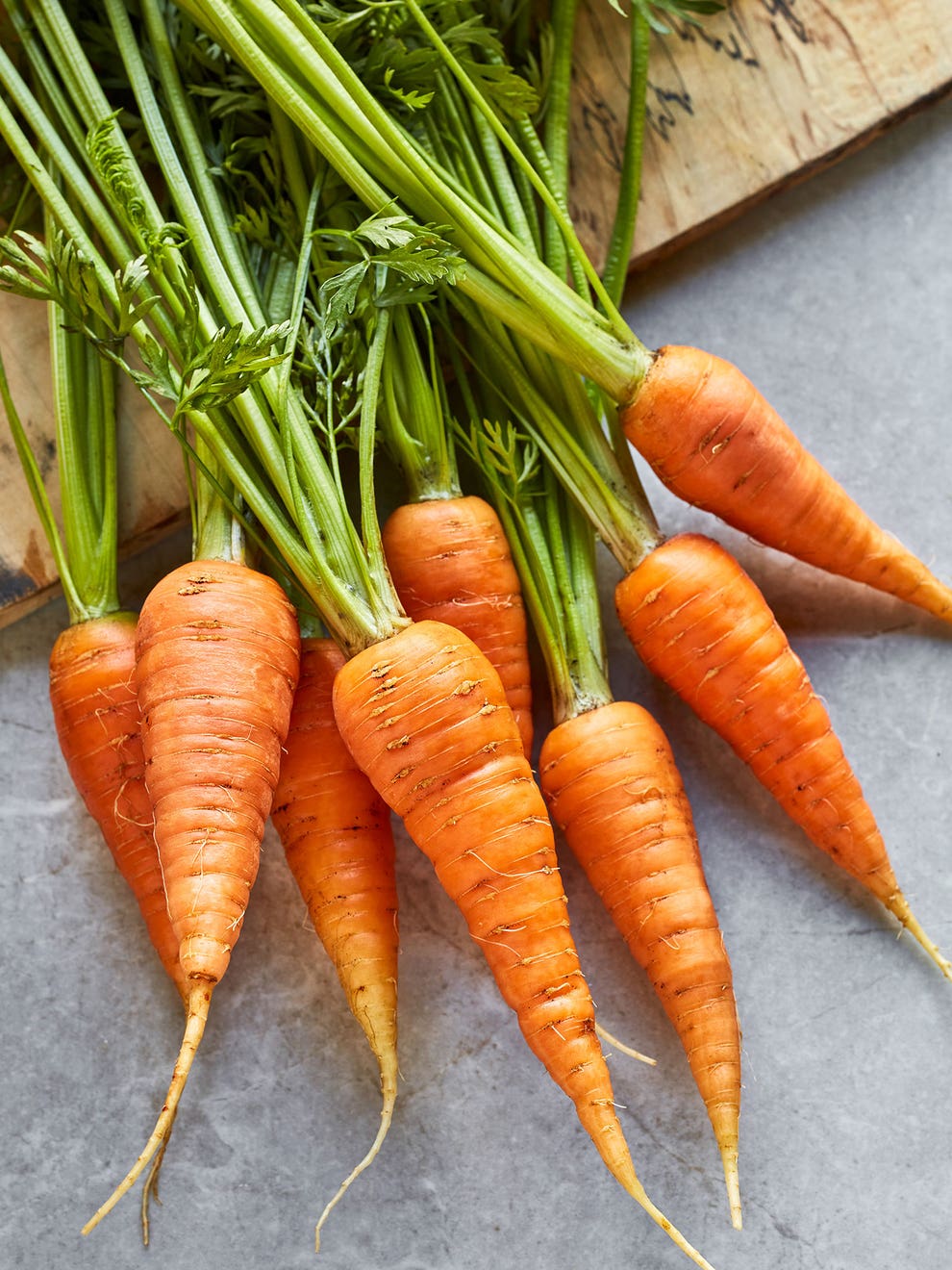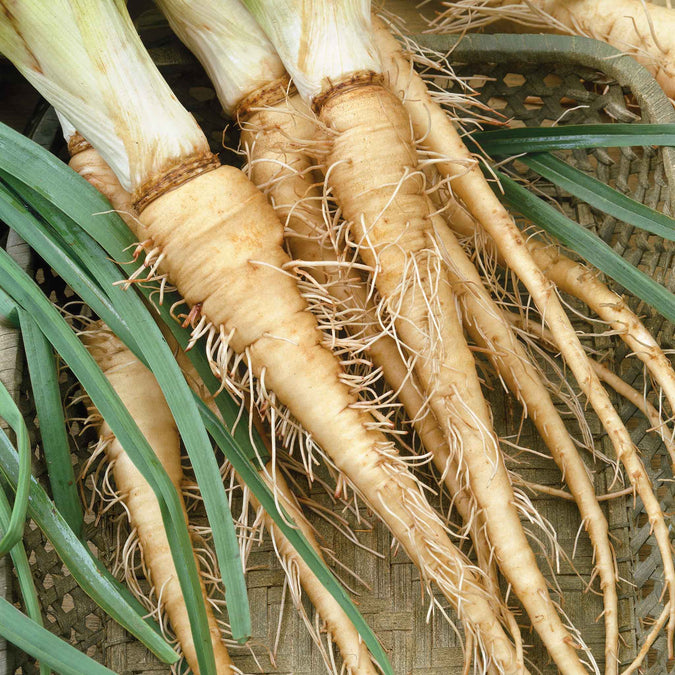
Carrots are a cool-season crop grown in spring. They are an excellent source of vitamin A and add color to a meal. They can be served cooked or raw.
This popular vegetable has a natural sweetness—especially the homegrown carrot because the sugar that makes a carrot sweet begins to be replaced by fiber as it ages in the grocery stores.
Plus, the home gardener has so many more varieties to grow from Belgium Whites to Purple Dragon to Parisian heirlooms that are round! (Not all carrots are the grocery store shape.) In fact, don’t expect to get perfectly straight ”grocery store” carrots. Your carrots will still taste better, whatever their shape!
Carrots have a reputation of being difficult to grow, especially in heavy, compacted soil. However, with a little effort, you can indeed grow carrots. Learn more in our planting guide below.
For more information on how to grow Carrots click the following hyperlink to Farmers Almanac Carrots.
For other resources please click on Cornell Universities Carrots link or click on Gardening Know How's Carrots link.
Parsnips are a hardy, cool-season crop planted in the spring, kissed by fall frost, and harvested before the ground freezes. Parsnips enrich soups and stews but can also be enjoyed as a side dish. Here’s how to plant, grow, and harvest parsnips in your garden.
Parsnips, popular with ancient Greeks and Romans, were brought over to the Americas with the first colonists. A relative of carrots and parsley, parsnips are biennials even though they’re usually grown as annual vegetables.
Parsnips need a long growing season and are best harvested after a few fall frosts; if planted too late in the season, their roots will be small.
Parsnips lend nutty, sweet flavor to any dish, but these root vegetables can also be enjoyed by themselves as a side dish. (Roasting is a favored method!) Plus, they are packed with nutrients, like potassium and vitamins B6 and C.
For more information on how to grow Parsnips click the following hyperlink to Farmers Almanac Parsnips.
For other resources please click on Cornell Universities Parsnips link or click on Gardening Know How's Parsnips link.
Salsify Also commonly referred to as black salsify (Scorzonera hispanica), scorzonera root vegetables may also be called black vegetable oyster plant, serpent root, Spanish salsify, and viper’s grass. It has a long, fleshy taproot much akin to that of salsify, but black on the exterior with white interior flesh.
For other resources please click on Gardening Know How's Salsify link.
Description: We've combined five distinct colors of carrots in one special blend for a pretty rainbow effect that is sure to be noticed at the dinner table, even by the kids. After testing hundreds of carrot varieties, we developed this easy-to-grow mix of five crispy carrots: Atomic Red, Bambino, Cosmic Purple, Lunar White and Solar Yellow. Smoothly tapered roots grow to 8" x 2" in loose soil.

Description: Cooks Garden Favorite. Hybrid. From the Dutch breeders that developed Napoli, the famous sugar carrot, comes this latest treat that sets a new standard for flavor. The 6 inch roots are bright orange with a blunt tip, retaining their extremely sweet and juicy, crisp-tender traits even if left in the garden plot for later harvests. An excellent choice for sweet desserts like Maple Carrot Cake.

Description: Market gardeners in Danvers, Massachusetts, developed this variety and shared it with Burpee in 1886. The root is a rich, dark orange and is 6-8" long. A first-class heirloom carrot for all soils.

Description: Mid-19th century variety is easy to grow, slim, cylindrical, orange roots are 7" long, 1½" thick, require no peeling, and are packed with vitamins. A favorite variety thanks to its productivity, delicious flavor, and wide adaptability. Garden Hint: For a continuing harvest of flavorful roots, sow seeds in early spring, and keep at it.

Description: ‘Touchon’ is considered the best of the Nantes-type carrots for fresh, crunchy eating. Works wonders fresh, glazed or roasted, in soups and stews. Free from hard fiber, this sweet and tender favorite French heirloom quickly matures to about 6" long and 1" across.

Description: Easy to grow and full of vitamins, this rich, sweet flavored carrot has 4" roots that are bright orange to the center. It was bred especially for heavy or poor soil and can also be grown in large containers. Burpee Exclusive. GARDEN HINTS: Sow seed in deep, well-worked stone-free soil after danger of heavy frost in the spring. Do not transplant because crooked roots may result.

Description: Exceptionally sweet flavor, high beta carotene content, and resistance to a wide range of diseases. This super long, slim carrot grows to 12" and keeps its tenderness and flavor-its the ultimate snack.

Description: Sweet. Sweeter. Sweetest. ‘Purplesnax’ is one supersweet, crazy-crunchy, nutrition-rich, deliriously delicious purple carrot. One of the very sweetest carrots, ‘Purplesnax’ is a hit with kids: an instant snack packed with sweet flavor, crunch, and nutritious carotene. Long, straight, easy-growing, German-bred Nantes-Imperator type produces great big, delicious crops, even in challenging conditions.

Description: Gorgeous deep orange baby carrots are loaded with flavor. A favorite of gourmets, 2-3" Caracas carrots are container-perfect.

Description: An extra sweet, tiny Nantes type gourmet carrot only 4" long and 1" thick with smooth skin and small core. Perfect for serving whole and great for growing in containers.

Description: Perfectly purple feast of color! Sweet 7–8" tapered carrots make an irresistible ornamental display of color in salads, snacks or dips. Tall, healthy plants produce a profusion of purple for your eating pleasure! Color runs all the way through the root but will fade a bit when cooked, so use raw for full impact!

Description: Red Cored Chantenay is Burpee bred, easy to grow and full of vitamins. Short, thick roots, 5 1/2" long, taper to blunt end are golden orange and have good flavor. GARDEN HINTS: Sow seed in deep, well-worked stone-free soil after danger of heavy frost in the spring. Do not transplant because crooked roots may result. A 1,500 seed packet sows a 40 row.

Description: Sweet and crunchy as hard candy, this Imperator type carrot is straight and slender, with deep-orange roots up to 12 inches long and 1 inch wide. The hybrid vigor produces high quality roots with wonderful texture, crunchy and with excellent flavor. Harvest in about 60 days.

Parsnip Seeds, Half Long Guernsey:
Description: The Guernsey variety was the most popular parsnip of the 19th century. Introduced prior to the 1850s, this variety is medium long, and has thick shoulders and smooth white skin. The flavorful flesh gets even sweeter after a good frost in autumn. In 1898, Nebraska Seed Company of Omaha said, “As name indicates, not as long as the Hollow Crown. Quality very sweet and delicate.”

Description: Delicious, tender, white 12-inch roots have a sweet flavor; refined in appearance. Great boiled, fried, or used in “Parsnip Bread.” A good producer and popular variety.

Description: Tasty, white, long roots, sweet flavor. Harvest after frost; a standard in all fall gardens. A popular variety in the 1820s.

Salsify Seeds Mammoth Sandwich Island:
Dating back to the 1800s where it is native to Europeans who would cook Salsify in soups and stews. All parts of the plant are edible and deserve its place in every period or permaculture garden. Plant in the spring and dig up roots in the fall and into the winter. Cold hardy and reseeds, so dead-head to control spreading and either eat flowers or harvest seeds for next spring.
